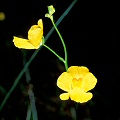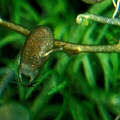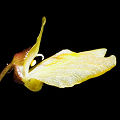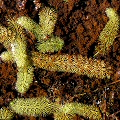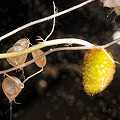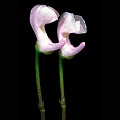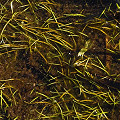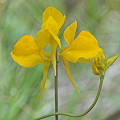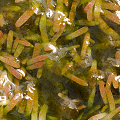Q: About affixed aquatic Utricularia
A: Affixed aquatic Utricularia species
are very much like suspended aquatics in general form, but which prefer to have at least some of their shoots
embedded in the substrate. Very often they have two types of shoots (they are dimorphic). Some of the shoots are leafy and green
and float in the water. They may have few or no bladders. The other shoots are white and anchor the
plant into the muck. These shoots usually have lots of bladders. Fine examples of dimorphic species
are U. intermedia, U. minor,
and U. ochroleuca. These can be hard to grow unless you treat them like
Aldrovanda. A submerged mesh bag with Typha
leaf litter can easily separate failure from success.
A subset of affixed aquatics are called subaffixed aquatics. These are plants that are
practically terrestrial species, and might even be grown
as terrestrials, but that do better if grown with the soil surfaces of their pots submerged by a few cm of water. If you get one
of these plants, I recommend you start them as very wet terrestrials, then once they are established you can submerge the
pots.
Excellent examples of subaffixed aquatics are U. cornuta, U. juncea, and
U. resupinata. Utricularia gibba is also a
subaffixed aquatic, but it is a little more of a suspended aquatic than a terrestrial. It will grow as a suspended aquatic, but
it will not flower in that state unless it forms such a thick mat that it has effectively made its own substrate.
I consider U. uliginosa to be a subaffixed aquatic since I have found it much prefers
to be submerged once it becomes established in a pot.
I have an old article about growing Utricularia gibba on line,
but here is an extraction from it for your convenience.
"For a growing container, you need a sturdy undrained pot or tub at least 7-10 cm deep and about 15 cm or larger in
diameter. In this container lay 2-3 cm of premoistened peat moss, peat-sand, or Sphagnum. Add a
top dressing of a few centimeters of washed sand. The sand layer weighs down the peat so the water stays clear....Carefully
add enough pure water to submerge the sand a few centimeters....I usually prepare a new tub a few days before I need it.
This is to let the chemistry of the water equilibrate before introducing the plants."
"Planting the Utricularia is trivial. Make a depression in the sand layer and wedge the plant
into it. Then anchor it with sand, allowing some parts to still get light for photosynthesis. Thereafter keep the water table a
few to several cm above the top of the sand. The plant will grow rapidly, making some stolons that wind through the sand and
peat layers and others that float freely in the water."
Page citations: Lloyd, F.E. 1942; Rice, B.A. 1994b, 2006a;
Taylor, P. 1989; personal observations.
